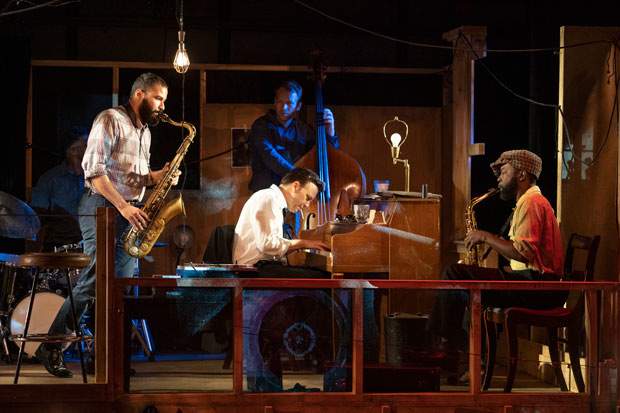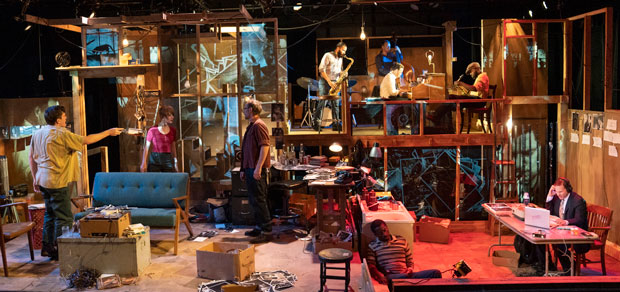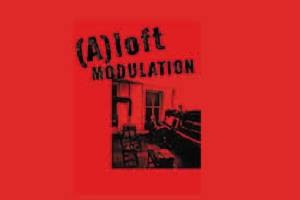A Jazzy Fusion of Fact and Fiction in (A)loft Modulation
Jaymes Jorsling’s new play makes its world premiere, presented by the American Vicarious.

(© Joan Marcus)
It's a bad sign when a play driven by a central mystery waits until the beginning of its second act — especially when the first act sprawls over 90 minutes — to establish what that mystery actually is. Jaymes Jorsling's (A)loft Modulation, making its world premiere at A.R.T./New York Theatres in an American Vicarious production, is nothing if not thoroughly unusual: an ambitious mix of conventional character drama, dramatic reenactment, and live jazz concert. But Jorsling's frustratingly scattered play never becomes anything more than the sum of its intriguing parts.
Taking place from 1957 to '64 and in the present day, (A)loft Modulation is inspired by real people and a real place: the so-called Jazz Loft, located at 821 6th Ave. in Manhattan, where photographer W. Eugene Smith famously moved after quitting his job at Life magazine and leaving his family in Croton-on-Hudson, New York. It is in this dilapidated space that jazz legends like Charles Mingus, Bill Evans, and Sonny Rollins improvised, riffed, and hung out late into the night. Smith not only took more than 40,000 photographs of life in the loft, but also wired the whole building and recorded 4,500 hours of audio, capturing all manner of comings and goings. Only through the efforts of Sam Stephenson, a writer and academic who spent 13 years researching Smith and published the book The Jazz Loft Project in 2009, has the Jazz Loft become widely known.

(© Joan Marcus)
(A)loft Modulation offers fictionalized dramatizations of some of Smith's recordings, with Myth Williams (P.J. Sosko, impassioned in his mania) standing in for Smith; Way Tonniver (Eric T. Miller, considerably warmer in manner) standing in for Smith's next-door neighbor, Juilliard music teacher Hall Overton; and Charlie Hudson III, Elisha Lawson, Spencer Hamp, Christina Toth, and Buzz Roddy playing a variety of other characters entering and exiting the premises. Jorsling's play also intersperses present-day scenes featuring Steve Samuels (Kevin Cristaldi, matching Sosko's driven nature), a nondescript businessman listening to the recordings that are being acted out for us; and his wife, Annie (Julia Watt, sympathetic in a thankless role), who introduced him to the tapes and now looks on in horror as Samuels's obsession consumes him personally and financially.
Steve Samuels is meant to mirror Myth Williams, with both characters risking destruction to find their own authentic selves: Myth obsessed with capturing truth at all costs, Steve obsessed with discovering a greater purpose in his life. But these one-dimensional characters stubbornly remain concepts throughout, because Jorsling and director Christopher McElroen's chief preoccupation is with evoking the look, feel, and sound of life in this grungy oasis of artistic creation.

(© Joan Marcus)
As a simulacrum, (A)loft Modulation certainly impresses. Troy Hourie's set is breathtaking in its detailed re-creation of a messy New York loft in the late 1950s and early '60s, crammed to the gills with Leila Ben-Abdallah's props. With the set visible to the audience even before the play begins, you can practically feel the squalor these characters live in. Adam J. Thompson's video designs add to the show's feel of a multimedia mélange, with projected live video of the reel-to-reel tapes playing the historic recordings, alternating with archival photographs of some of the real inhabitants of the Jazz Loft. Andy Evan Cohen's sound design in turn offers smooth transitions from the sound of recorded dialogue and music to that of the performers picking up scenes mid-recording, including a live band, led by music director and saxophonist Jonathan Beshay, performing original music by Gerald Clayton.
The meticulous production elements do visually suggest the tunnel vision of both its central characters. And the fact that the plot, such as it is, doesn't even make itself apparent until about halfway through the play could be said to reflect Steve's own aimlessness: He knows he's looking for something in these recordings, but he's not even sure what until the end.
None of this, though, comes close to an involving drama. Instead, (A)loft Modulation ends up feeling more like a fetish object — so preoccupied with its period re-creations and reenactments of archival video and sound that it effectively leaves the audience on the outside looking in, wondering what the point of this baggy, draggy, two-and-a-half-hour spectacle really is. Perhaps it's not only the characters, but the playwright and director themselves who could use a broader sense of perspective.

(© Joan Marcus)









